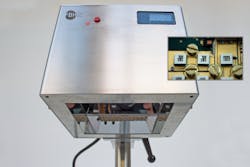UVC LED irradiation could kill MDR pathogens, without side effects
Knowing that multidrug-resistant (MDR) pathogens often cannot be treated with antibiotics, researchers in the Ferdinand-Braun-Institut (FBH)'s Joint Lab GaN Optoelectronics and Technische Universität Berlin (both in Berlin, Germany) have developed a novel LED irradiation system that aims to kill microorganisms with far-ultraviolet (UVC) light, and do so without any side effects.
Irradiation with UVC light can be used to destroy microorganisms without allowing resistances to develop. The LEDs that the research team developed emit at wavelengths around 230 nm and provide more than 1 mW of output power; such UVC LEDs are not yet commercially available worldwide due to technological challenges of the aluminum gallium nitride (AlGaN) system. Their light does not penetrate into the living layers of the skin because of their high degree of absorption, so it is expected that the skin will not be harmed at all or will be damaged so little that the natural repair mechanisms compensate for the effect. The researchers hope that this will help to kill MDR pathogens without any long-term side effects.
Within the framework of the VIMRE project (prevention of infection with multidrug resistant pathogens via in vivo UVC irradiation), FBH has developed and produced an irradiation system comprising an array of 118 of these LEDs on an 8 × 8 cm area. It achieves a maximum irradiation power of 0.2 mW/cm2 with more than 90% uniformity over a 6 × 6 cm area. The first prototype was delivered to the Department of Dermatology at Charité – Universitätsmedizin Berlin for skin examinations. Another device will soon be delivered to the Institute for Hygiene and Environmental Medicine of the University Medicine Center Greifswald to clarify the microbicidal effectiveness.
Tests carried out by the two project partners with these devices are intended to show that UVC irradiation is suitable for killing microorganisms and especially MDR pathogens (eradication). At the same time, they will demonstrate that this exposure is harmless to humans as long as specific irradiation doses are maintained. This will be verified using tissue samples of human skin as well as skin and mucosa models, since the preferred habitat of microorganisms such as MDR pathogens is the anterior nasal cavity and the pharynx. For this purpose, the Charité conducts dose-dependent investigations of possible DNA damage to irradiated skin. The University Medicine Center Greifswald will determine how effectively the UV LED emitters kill MDR pathogens at 230 nm and compare the results with those of UV lamps with emission at 254 nm and 222 nm.
The UV LED irradiation system will be further developed so that pathogens can be eliminated in places that are difficult to access. The device might also be interesting for coronaviruses, as they can also be inactivated by shortwave UVC light. Since SARS-CoV-2 replicates in the pharynx in the first phase, it seems plausible to use such light sources in this part of the body to prevent COVID-19 disease.
